Paper crafting transforms ordinary sheets into extraordinary creations with just a few simple tools and techniques. Whether you’re a parent looking for engaging activities, a teacher seeking classroom projects, or someone who loves making beautiful things with their hands, paper crafts offer endless possibilities for creativity and self-expression.
The beauty of paper crafting lies in its accessibility. Unlike many hobbies that require expensive equipment or specialized skills, paper craft ideas can be executed with materials you likely already have at home. From quick 5-minute projects that provide instant satisfaction to more elaborate decorations that can transform your living space, paper crafts cater to every skill level and time commitment.
In this comprehensive guide, you’ll discover over 25 easy paper craft projects that range from fun decorations and useful organizers to wearable accessories and seasonal celebrations. Each project includes clear instructions, material lists, and tips for success, ensuring that even complete beginners can create gorgeous piece after gorgeous piece.
- Low-Barrier Accessibility of Paper Crafting: Paper crafting is highly accessible, requiring only common materials and simple tools, making it suitable for all skill levels and easily integrated into daily activities.
- Essential Tools and Materials: Core supplies such as scissors, glue, and various types of paper form the foundation for a wide range of projects, with additional optional items like markers and ribbons enhancing creativity.
- Variety of Project Types and Themes: From quick crafts like paper chains and fans to detailed decorations like paper flowers and snowflakes, paper crafts encompass seasonal, decorative, useful, and wearable items for every occasion.
- Techniques and Tips for Success: Mastering basic skills such as cutting, folding, and gluing, along with organizational strategies and troubleshooting, ensures high-quality results and builds confidence for more complex projects.
- Creative and Practical Benefits of Paper Crafting: Paper crafts foster creativity, teach important skills like spatial reasoning and color theory, and produce both beautiful decorations and useful items, enriching personal development and home aesthetics.
- What You’ll Need for Easy Paper Crafts
- Quick 5-Minute Paper Crafts
- Fun Paper Animals and Characters
- Decorative Paper Crafts for Your Room
- Useful Paper Projects
- Paper Jewelry and Accessories
- Seasonal Paper Craft Ideas
- Paper Craft Tips for Success
- FAQ
- How can I troubleshoot problems encountered during paper crafting?
- What are some ideas for seasonal paper crafts?
- Can I make quick and simple paper crafts if I have little time?
- How does understanding different types of paper improve my craft projects?
- What basic tools and materials do I need to start paper crafting?
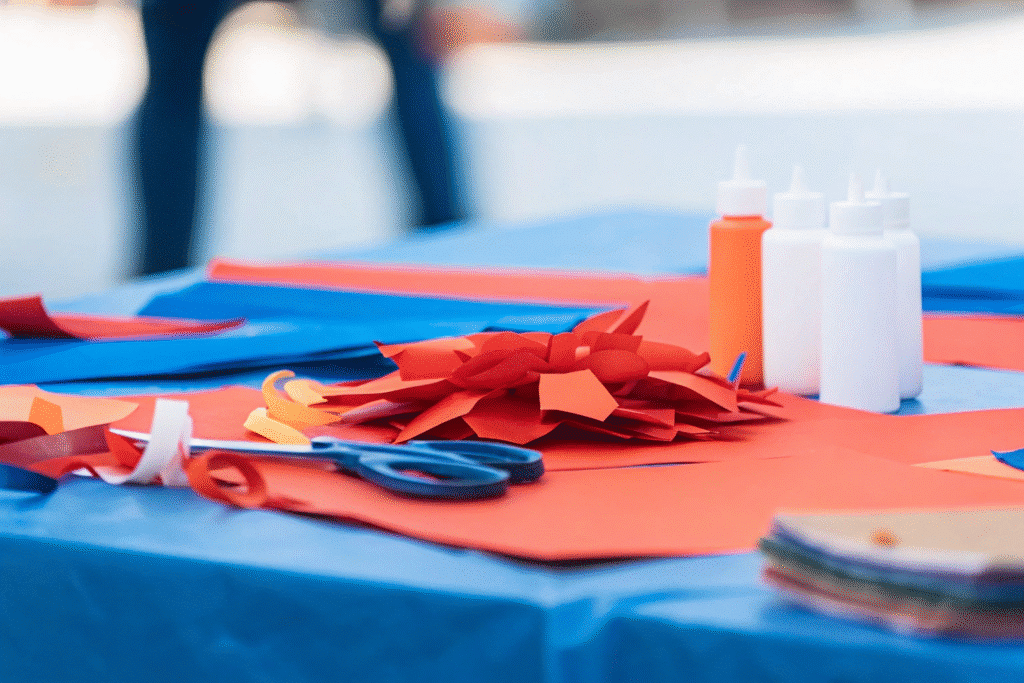
What You’ll Need for Easy Paper Crafts
Starting your paper crafting journey requires surprisingly few materials, making it an easy project for anyone to begin. The essential tools form the foundation for countless creative possibilities, and most can be found in any household or purchased inexpensively at local stores.
Basic Tools Overview
The core tools for paper crafts include sharp scissors, a reliable glue stick, an assortment of colored paper, and a ruler for precise measurements. These four items alone can create dozens of different projects, making paper crafting one of the most cost-effective creative hobbies available.
For families with children, safety scissors designed with blunted tips and smaller handles ensure that kids can participate safely in the crafting process. The smaller size also provides better control for young hands learning to cut along lines and create shapes.
Adults and those working on precision projects benefit from craft knives or paper trimmers, which deliver clean, straight cuts that elevate the finished appearance of any project. When using cutting tools, always work on a cutting mat to protect your work surface and achieve better control over your cuts.
Paper Varieties and Their Uses
Understanding different paper types dramatically improves your project results. Construction paper serves as the workhorse of paper crafting, offering excellent thickness, vibrant colors, and forgiving handling properties that make it perfect for beginners and children’s projects.
Cardstock provides superior durability and structure, making it ideal for projects that need to stand up or hold their shape over time. Geometric paper bowls, greeting cards, and organizer boxes all benefit from cardstock’s rigid properties.
Tissue paper, while delicate, creates beautiful effects in paper flowers and layered decorations. Its translucent quality adds depth and movement to paper flowers and window decorations. When working with tissue paper, handle it gently and use minimal glue to prevent tearing.
Patterned paper and decorative sheets expand your creative palette, offering textures, prints, and finishes that add professional polish to any project. Even scraps of patterned paper can be incorporated into collages and mixed-media pieces.
Essential Supplies for Success
Beyond the basic four tools, several optional supplies can enhance your paper crafting experience. Colored pencils, markers, and crayons allow for personalization and detailed decoration of your creations. These drawing tools help transform simple cut shapes into unique, expressive pieces.
String, ribbon, and wooden skewers add dimensional possibilities to flat paper projects. They enable the creation of mobiles, garlands, and puppet-style crafts that move and interact with their environment.
For projects requiring stronger adhesion, hot glue provides a permanent bond, though it requires adult supervision when children are involved. Double-sided tape offers a clean alternative for layering without the moisture that can wrinkle delicate papers.
Quick 5-Minute Paper Crafts
When time is limited but creativity calls, these rapid paper crafts deliver immediate satisfaction and beautiful results. Perfect for busy schedules, classroom activities, or those moments when you need a quick fun decoration, these projects prove that great crafts don’t require hours of work.
Paper Chain Magic
Paper chains represent one of the most versatile and instantly gratifying paper crafts available. Using colorful strips cut approximately 1 inch by 6 inches, these decorations can transform any space in minutes. The technique is surprisingly easy: apply a small amount of glue to one end of a strip, form a loop, and thread the next strip through before sealing it.
The beauty of paper chains lies in their adaptability. Create short chains for napkin rings at dinner parties, medium chains for birthday party decorations, or extraordinarily long chains to drape across entire rooms. Children love making paper chains because each link represents visible progress, and the repetitive nature is both calming and engaging. Paper chain crafts can also be turned into colorful snakes for playful décor, adding a fun twist to this classic craft.
For special occasions, experiment with themed color schemes. Red, white, and blue paper chains celebrate patriotic holidays, while rainbow chains bring joy to any celebration. The project requires only scissors glue and colored paper, making it perfect for spontaneous crafting sessions.
Instant Paper Fans
Accordion-folded fans provide immediate relief on hot days while serving as charming decorations year-round. This technique teaches fundamental folding skills while creating functional art pieces. Start with a rectangular sheet of paper and make consistent folds of approximately 1-2 centimeters, alternating between valley and mountain folds.
The key to successful fan-making lies in maintaining consistent fold widths. Use a ruler to mark your first few folds, then use those as guides for the remaining sections. Once folded completely, secure one end with tape or glue, then gently spread the other end to reveal your fan.
Fans become super fun when decorated before folding. Draw patterns, add stickers, or create rainbow effects across the paper surface. When folded, these decorations create surprising patterns that emerge as the fan opens.
Basic Origami Butterflies
Origami butterflies introduce the ancient art of paper folding through an achievable project that yields delightful results. Using a square piece of paper, this project requires approximately 8-10 folds to transform flat white paper or colored sheets into recognizable butterfly forms. Simple origami animals are a great way to engage children in craft activities, making the process both educational and enjoyable.
Begin with your paper positioned as a diamond, colored side down. The first folds create the basic structure, while subsequent folds define the butterfly wings and body. The beauty of origami lies in its precision—each fold must be sharp and accurate for the final form to emerge correctly.
These butterflies make excellent decorations when attached to string for mobiles, glued to wall art, or incorporated into greeting cards. The technique demonstrates how paper’s inherent properties can be manipulated to create three-dimensional forms from two-dimensional materials.
Paper Plate Transformations
Paper plate masks combine the structural support of pre-formed plates with the creative possibilities of construction paper decoration. This hybrid approach simplifies the crafting process while ensuring sturdy, wearable results.
Cut eye holes in the plate, then let creativity guide the decoration process. Animals, superheroes, or fantasy creatures all emerge through clever use of colored paper, markers, and scissors. The plate’s curved surface naturally fits facial contours, making these masks comfortable for extended wear.
For birthday party activities, prepare plain plates and provide an assortment of decorating materials. Children can create their own character masks, turning the crafting process into entertainment that doubles as a party favor.
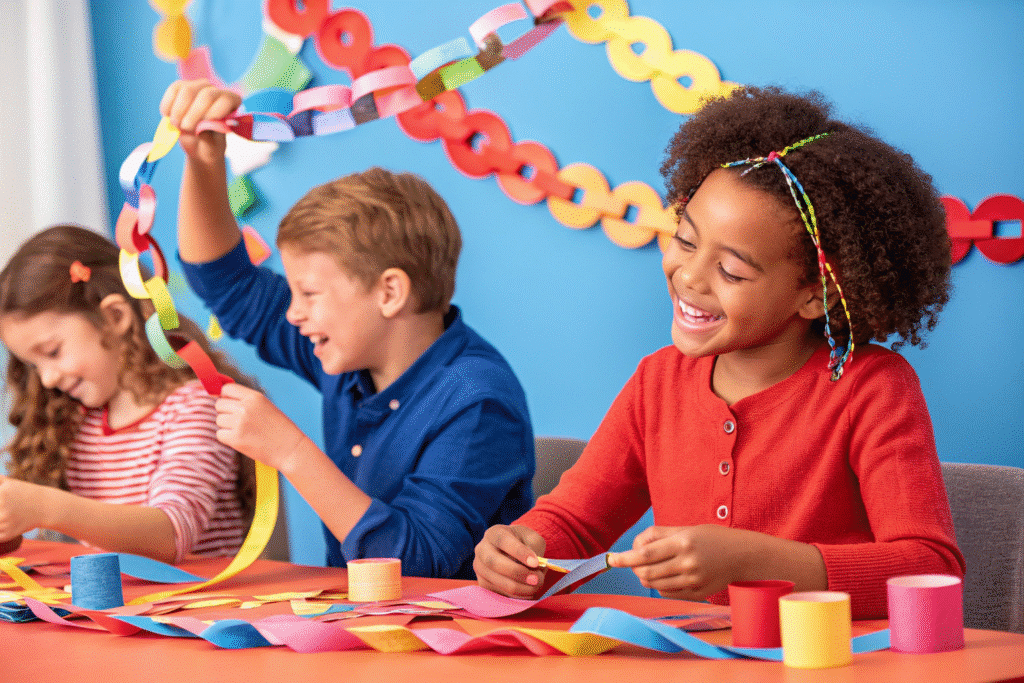
Fun Paper Animals and Characters
Creating paper animals and characters brings stories to life while developing fine motor skills and creative thinking. These projects combine basic shapes with imaginative details, resulting in charming figures that can populate entire paper worlds.
Toilet Paper Roll Owls
Toilet paper rolls provide the perfect cylindrical base for owl bodies, demonstrating how everyday items can become crafting gold. This upcycling approach teaches resourcefulness while creating adorable creatures that children love making and displaying.
Cover the roll with construction paper, securing it with glue or tape. The magic happens when adding the owl’s distinctive features. Cut feather patterns into the paper covering, or layer different colored papers to create texture and depth. Googly eyes instantly bring the owl to life, though hand-drawn eyes work equally well.
The beauty of toilet paper roll crafts lies in their stability. Unlike flat paper figures, these three-dimensional owls stand independently, making them perfect for shelf displays or imaginative play scenarios. Create entire families of owls using different colored papers and varying the decorative details.
Paper Bag Puppet Theater
Paper bag puppets transform ordinary lunch bags into interactive characters that encourage storytelling and dramatic play. The bag’s natural fold line creates a movable mouth, adding an element of animation that delights both creators and audiences.
Decorate the bag with construction paper features, creating everything from friendly animals to storybook characters. The flat surface of the bag provides ample space for detailed decoration, while the bag’s opening accommodates a child’s hand for manipulation.
These puppets excel in educational settings, where they can represent historical figures, book characters, or original creations. The whole family can participate in puppet shows, with each member creating and voicing their own character.
Majestic Paper Lions
Construction paper lions showcase the power of accordion folding to create texture and volume. The lion’s mane, formed through careful accordion folding, demonstrates how paper manipulation can simulate natural textures while teaching important crafting techniques.
Create the lion’s face as a simple circle, then attach the accordion-folded mane around the perimeter. The contrast between the smooth face and textured mane creates visual interest and dimensional appeal. Add simple features with markers or cut paper shapes to complete the regal appearance.
This project introduces children to radial symmetry concepts while allowing for creative expression in mane styling and facial features. Each lion develops its own personality through the creator’s choices in color, expression, and decorative details.
Hopping Origami Frogs
Engineering meets artistry in origami frogs that actually hop when pressed. This project demonstrates paper’s elastic properties while creating an interactive toy that provides endless entertainment. The clever fold pattern stores energy in the paper’s structure, releasing it when the frog’s back is pressed.
The hopping mechanism relies on precise folding that creates tension within the paper structure. Each fold must be sharp and accurate for the final product to function correctly. This project requires patience and attention to detail, making it slightly more challenging than basic origami projects.
Once completed, these frogs become the stars of impromptu games and competitions. Children naturally organize hopping contests, measuring distances and perfecting their pressing techniques for maximum hop distance.
Decorative Paper Crafts for Your Room
Transform your living space with handmade decorations that reflect your personal style while demonstrating advanced paper crafting techniques. These projects focus on creating beautiful, lasting decorations that enhance any room’s ambiance.
Giant Paper Flowers
Three-dimensional paper flowers bring natural beauty indoors while showcasing sophisticated layering techniques. Using tissue paper, cupcake liners, or construction paper, these blooms can range from delicate small flowers to dramatic giant paper flowers that serve as focal points in room design. Paper flowers can add beauty to any room and require simple materials, making them an accessible craft for all skill levels.
The layering technique creates realistic depth and movement, with each petal layer contributing to the overall dimensional effect. Pipe cleaners or floral wire provide structural support while allowing for natural-looking curves and positioning.
Color selection dramatically impacts the final appearance. Monochromatic schemes create elegant, sophisticated looks, while rainbow arrangements bring energy and joy to any space. These flowers never wilt, making them perfect for long-term decorative schemes.
Illuminated Paper Lanterns
Paper lanterns combine functional lighting with decorative appeal, creating warm, inviting atmospheres in any room. The basic cylindrical construction can be enhanced with perforations, layered tissue paper, or decorative cutouts that create beautiful light patterns. Kids can make decorative paper lanterns to brighten up their space, turning this craft into a fun and creative activity.
Safety considerations are paramount when incorporating any lighting elements. LED lights or battery-operated tea lights provide illumination without fire risk, making these lanterns safe for children’s rooms and unsupervised display.
The construction process teaches cylinder formation and measurement skills while resulting in functional art pieces. Vary the sizes to create groupings, or make single statement pieces that anchor room corners or central spaces.
Intricate Paper Snowflakes
Paper snowflakes elevate the simple cutting technique into sophisticated art forms that demonstrate symmetry principles and negative space utilization. The folding process—typically into sixths or eighths—sets up the symmetrical patterns that unfold into complex, beautiful designs.
Each cut creates multiple pattern elements due to the folded structure, teaching how small actions can create large-scale effects. Experiment with different cutting patterns to discover how various approaches yield dramatically different results.
These snowflakes work beautifully as window decorations, where backlighting reveals their intricate patterns. Create collections in different sizes and hang them at varying heights for dynamic wall art displays that change with viewing angle and lighting conditions.
Personal Wall Art Collages
Wall art collages provide opportunities for abstract composition and personal expression while utilizing materials that might otherwise be discarded. Magazine pages, colored paper scraps, and decorative elements combine in endless variations to create unique artistic statements.
The collage technique originated in late 19th-century scrapbook culture and has evolved into a respected art form. Layering, overlapping, and juxtaposition create visual interest and emotional impact that reflects the creator’s aesthetic sensibilities.
This approach works particularly well for teenagers and adults who want to create personalized room decorations that reflect their interests, travels, or artistic vision. The process is meditative and therapeutic, making it as valuable for the creation experience as for the final result.
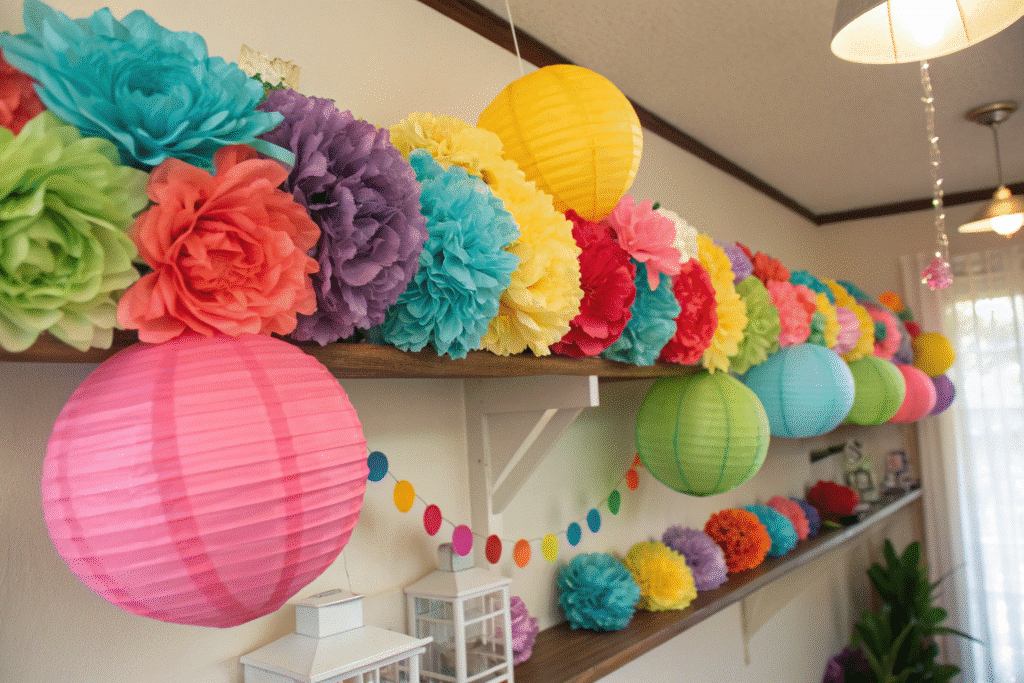
Useful Paper Projects
Functional paper crafts demonstrate how creativity and utility can merge to produce items that serve practical purposes while maintaining aesthetic appeal. These projects prove that handmade doesn’t mean purely decorative.
Personalized Bookmarks
Handmade bookmarks transform reading into a more personal experience while showcasing individual creativity. Using strips of construction paper or cardstock as the base, these functional items can be decorated with drawings, quotes, stickers, or collage elements that reflect the reader’s interests. Fruit slice bookmarks are a fun way to encourage reading among kids, combining functionality with playful designs.
The durability factor becomes important for items that will see regular use. Laminating finished bookmarks protects them from wear and tear while maintaining their decorative appeal. Ribbon attachments add elegance and functionality, making it easier to locate and extract bookmarks from thick volumes.
This project offers an excellent introduction to personalization in crafting. Each bookmark becomes unique through the creator’s choices in color, decoration, and theme. They make thoughtful gifts for book lovers and serve as perfect way to encourage reading habits in children.
Organized Desk Solutions
Paper organizer boxes demonstrate how geometric principles and precise folding can create functional storage solutions. Following specific templates and scoring techniques, cardstock transforms into sturdy containers perfect for holding desk supplies, craft materials, or small personal items.
The construction process teaches measurement accuracy and geometric visualization while producing genuinely useful results. Different sizes accommodate various storage needs, from paper clip containers to larger boxes for documents or supplies.
Modular designs allow multiple boxes to fit together efficiently, creating comprehensive organization systems. This approach shows how traditional origami principles can be applied to contemporary functional needs.
Heartfelt Greeting Cards
Custom greeting cards represent the intersection of personal expression and functional communication. The folding, layering, and decorating techniques involved create one-of-a-kind messages that carry far more emotional weight than commercial alternatives.
The card industry’s multi-billion-dollar scale indicates the continued importance of personal communication, making handmade cards particularly meaningful in an increasingly digital world. Recipients recognize and appreciate the time and thought invested in creating custom cards.
Techniques can range from simple folded constructions with basic decorations to complex pop-up mechanisms and layered dimensional effects. The complexity level can match the creator’s skill while still producing beautiful, meaningful results.
Custom Picture Frames
Paper picture frames utilize matting techniques and decorative borders to create personalized display options for photographs, artwork, or certificates. The construction process teaches proportion and design principles while producing functional display items.
Reinforcement techniques ensure these frames can support their intended contents while maintaining structural integrity. Layered construction and careful attention to corner reinforcement create surprisingly durable results from seemingly delicate materials.
The personalization possibilities are endless, from simple geometric patterns to elaborate decorative themes that complement specific photographs or room décor schemes.
Paper Jewelry and Accessories
Wearable paper art demonstrates the material’s versatility while creating unique accessories that make personal style statements. These projects combine traditional techniques with contemporary fashion sensibilities.
Paper Bead Necklaces
The art of creating paper beads traces back to Victorian times when resourceful crafters transformed wallpaper remnants and magazine pages into beautiful jewelry components. Modern paper bead making continues this tradition while incorporating contemporary materials and finishing techniques.
The rolling technique creates surprisingly durable beads when properly sealed. Varnish or clear nail polish provides water resistance and a professional finish that enhances the paper’s colors and patterns. Magazine pages offer particularly striking results due to their varied colors and text patterns.
Stringing completed beads into necklaces, bracelets, or earrings creates wearable art that generates conversation and admiration. Each piece becomes unique through the creator’s choice of paper sources and color combinations.
Royal Crown Headbands
Crown headbands combine precision cutting with decorative embellishment to create wearable royalty accessories. Cardstock provides the necessary rigidity to maintain crown shapes while allowing for intricate cutting patterns and decorative additions.
The design process involves planning peak heights, decorative elements, and overall proportions to create balanced, attractive crowns. Faux gems, glitter, and metallic paper additions enhance the regal appearance while teaching color coordination and design principles.
These crowns work excellently for birthday party activities, theatrical productions, or imaginative play scenarios. The creation process is as enjoyable as wearing the finished products.
Colorful Paper Rings
Paper rings utilize modular folding or strip construction to create stackable, interlocking accessories. The techniques involved teach tessellation concepts and structural engineering principles while producing wearable results.
Rainbow color schemes create particularly striking effects, while monochromatic approaches offer sophisticated elegance. The lightweight nature of paper rings makes them comfortable for extended wear while allowing for bold, dramatic designs.
Stacking multiple rings creates layered effects, while interlocking designs demonstrate how individual components can combine into more complex structures.
Friendship Paper Bracelets
Paper friendship bracelets adapt traditional textile techniques to paper materials, creating meaningful gifts that celebrate relationships. The weaving and braiding processes teach pattern recognition and sequential thinking while producing wearable tokens of friendship.
Strong paper or thin cardstock works best for these projects, providing flexibility for braiding while maintaining durability for regular wear. Color sequencing creates personal meaning, with friends often choosing complementary or matching color schemes.
The tradition of exchanging friendship bracelets gains new dimensions when the recipients have participated in creating the gifts themselves, making the exchange ceremony more meaningful and memorable.
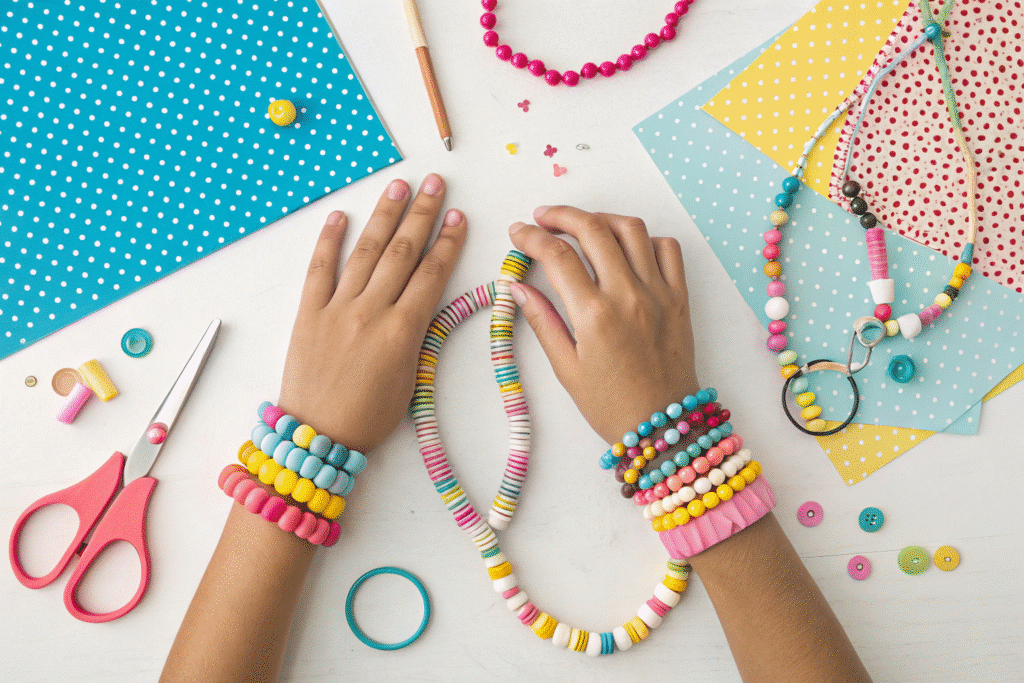
Seasonal Paper Craft Ideas
Seasonal crafts connect our creative activities with natural cycles and cultural celebrations, providing opportunities to create decorations and gifts that enhance special occasions throughout the year.
Halloween Spookiness
Black construction paper transforms into classic Halloween imagery through simple cutting and shaping techniques. Bats with angular wings and spiders with segmented legs create atmospheric decorations that capture the holiday’s playful spookiness.
The contrast between black paper and lighter backgrounds creates dramatic silhouette effects that work particularly well for window decorations. When backlit, these silhouettes create engaging shadow displays that enhance Halloween ambiance.
Movable elements like dangling spider legs or bat wings that flutter in air currents add kinetic interest to static decorations. String attachments enable hanging displays that create three-dimensional decorative schemes.
Christmas Cheer
Christmas paper ornaments encompass diverse cultural traditions, from intricate German paper stars to Scandinavian woven hearts. Each tradition offers unique techniques and aesthetic approaches that enrich the holiday crafting repertoire.
Origami stars demonstrate geometric folding principles while creating elegant decorations suitable for tree hanging or table displays. The precision required for successful origami star creation teaches patience and attention to detail. 3D paper stars are easy to make and can be used for various celebrations, adding a festive touch to any event.
Layered paper trees and gift tags provide opportunities for color experimentation and personal expression while serving functional roles in holiday celebrations. These items can be customized to match family traditions or personal aesthetic preferences.
Valentine’s Romance
Heart-shaped garlands combine cutting accuracy with assembly techniques to create romantic decorations suitable for Valentine’s Day celebrations. The repetitive heart cutting process can be meditative while building cutting skills and color awareness.
Pop-up card mechanisms add surprise elements to Valentine greetings, demonstrating how paper engineering can create memorable interactive experiences. The mechanical aspects teach cause-and-effect relationships while producing delightful results.
Three-dimensional heart sculptures utilizing layering and folding techniques create impressive displays that showcase advanced paper manipulation skills while celebrating love and friendship themes.
Spring Awakening
Spring garden scenes bring together multiple paper crafting techniques in cohesive displays that celebrate seasonal renewal. Paper flowers, butterflies with delicate butterfly wings, and busy bees create layered compositions that capture spring’s energy and beauty.
The layering approach allows for complex compositions that tell stories or create environmental scenes. Bright colors and three-dimensional elements combine to create displays that bring natural beauty indoors.
These projects work excellently in educational settings where they can complement lessons about biology, seasons, or environmental awareness while providing engaging hands-on activities.
Paper Craft Tips for Success
Mastering paper crafting requires understanding both technical skills and creative approaches. These strategies ensure successful project outcomes while building confidence for more ambitious future endeavors.
Starting Your Journey
Beginning crafters benefit from selecting projects that match their current skill level while providing clear learning opportunities. Paper chains and simple fans offer immediate success while teaching fundamental cutting and folding techniques that apply to more complex projects.
Workspace organization dramatically impacts both enjoyment and success rates. Designating specific areas for different supplies—cutting tools, adhesives, papers, and decorating materials—reduces frustration and increases efficiency during creative sessions.
The learning progression should move gradually from simple techniques to more complex combinations. Master basic folding before attempting origami, and perfect straight cutting before trying intricate patterns.
Technical Excellence
Adhesive application requires restraint and precision to achieve professional-looking results. Excess glue creates wrinkled surfaces and visible mess, while insufficient adhesive leads to project failure. Practice finding the right amount through experimentation on scrap paper.
Cutting technique affects every aspect of project appearance. Sharp tools, steady hands, and proper body position contribute to clean, accurate cuts that elevate finished project quality. Regular tool maintenance ensures consistent performance.
Folding requires pressure and precision to create sharp, lasting creases. Using bone folders or similar tools creates professional-quality folds that maintain their shape over time.
Creative Development
Color theory principles enhance project appeal and emotional impact. Understanding complementary colors, analogous schemes, and contrast principles helps creators make choices that support their artistic goals.
Personal expression should guide decoration choices rather than rigid adherence to examples. While learning basic techniques, encourage experimentation with color, pattern, and embellishment to develop individual style.
Pattern recognition and spatial relationships develop through practice with geometric designs and symmetrical patterns. These skills transfer to other creative disciplines while enhancing mathematical understanding.
Problem-Solving Strategies
When projects don’t unfold as expected, analysis and adaptation often save the day. Understanding why techniques work helps troubleshoot problems and modify approaches for better results.
Scrap paper serves as a valuable testing ground for new techniques or uncertain measurements. This low-risk experimentation builds confidence while preventing waste of good materials.
Documentation of successful techniques and pleasing color combinations creates a personal reference library for future projects. Photos or sketches preserve discoveries for later application.
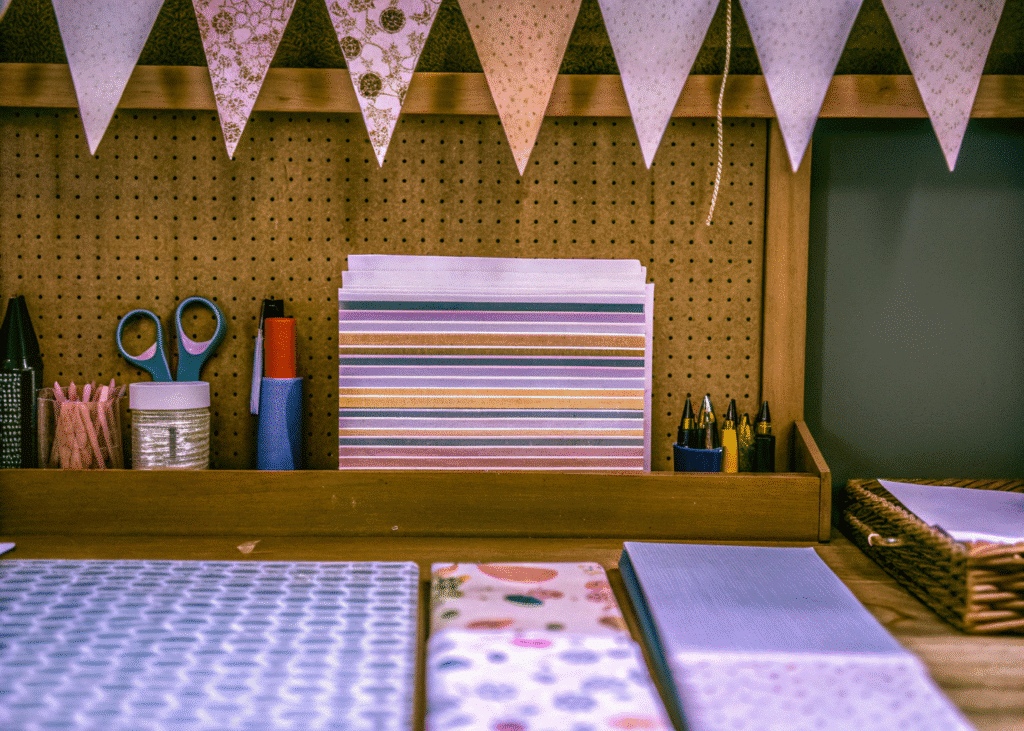
Paper crafting opens doorways to creativity that cost little but reward greatly. From quick paper chains that transform spaces in minutes to intricate seasonal decorations that celebrate life’s special moments, these easy craft using paper projects prove that extraordinary beauty can emerge from the simplest materials.
The journey from basic paper and scissors to sophisticated three-dimensional creations teaches valuable skills that extend far beyond crafting. Patience, precision, color theory, and spatial reasoning all develop through hands-on paper craft experiences. Children gain fine motor skills and confidence, while adults discover stress relief and creative satisfaction.
Whether you’re seeking a fun decoration for this weekend’s party, planning activities for a birthday party celebration, or simply wanting to create something beautiful with your hands, paper crafts offer solutions that fit any schedule, budget, or skill level. The printable template resources and free template options available online expand possibilities even further, providing professional designs that ensure successful results.
Start with simple projects that appeal to your current interests and skill level. Master the basics of cutting, folding, and gluing before progressing to more complex techniques. Remember that every expert crafter began with their first paper chain or origami butterfly. Your creative journey starts with a single sheet of paper and the willingness to explore what’s possible when imagination meets technique.
The most rewarding aspect of paper crafting lies not just in the finished projects, but in the process itself. Each fold teaches patience, every cut builds precision, and all decoration choices develop aesthetic sensibilities. These skills compound over time, leading to increasingly sophisticated projects and greater creative confidence.
So gather your basic supplies, clear a workspace, and begin exploring the wonderful world of paper crafts. Your next great project is just a fold away.
FAQ
How can I troubleshoot problems encountered during paper crafting?
Troubleshooting involves analyzing what went wrong, testing techniques on scrap paper, and adjusting your methods. Developing a personal reference library with successful techniques and image references helps you refine your skills and improve results over time.
What are some ideas for seasonal paper crafts?
Seasonal paper crafts include Halloween silhouettes like bats and spiders, Christmas ornaments such as paper stars and layered trees, Valentine’s heart decorations, and spring-themed scenes with colorful flowers and butterflies.
Can I make quick and simple paper crafts if I have little time?
Yes, there are numerous quick paper crafts, such as paper chains and paper fans, that can be completed in just five minutes, providing instant satisfaction and decorating or entertaining even during busy schedules.
How does understanding different types of paper improve my craft projects?
Knowing the characteristics of various paper types, such as construction paper for general projects, cardstock for durability, and tissue paper for delicate decorations, helps you choose the right material for each project, resulting in better quality and more professional-looking crafts.
What basic tools and materials do I need to start paper crafting?
To begin paper crafting, you need essential tools like sharp scissors, a reliable glue stick, assorted colored paper, and a ruler for measuring. These items form the foundation for most projects and are inexpensive to acquire.


